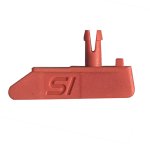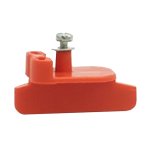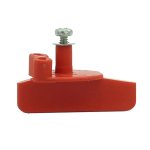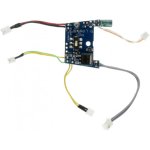June 25, 2015
In this review I’ll take a look at the Slot.it Audi R18 e-tron quattro Le Mans Test 2013, No.4, which features new four-wheel-drive technology. I’ll also be comparing the new Audi to an older 2WD version, Audi R18 TDI #1, Monza Test 2011 (SICA24A).
The fit and finish of the Audi is as expected from Slot.it; details are exceptional and the quality of the paint/printing is top notch. The sponsor logos and text are colorful and bright, and the satin black body color is even and executed nicely. This is a very nice example of the full size R18 and you’ll be hard pressed to not enjoy this scaled down model in the looks department alone.
Looking underneath at the chassis, the usual hardware from Slot.it can be seen. One thing to note about the screws that Slot.it uses now is that they are no longer stainless steel. This is a bonus in my book as it makes things easier with use of a magnetized screwdriver, meaning less chance of dropping a screw. Also of note is that the Flat 6 motor is no longer yellow, but just a bare metal can. You can see it here in its stock anglewinder configuration.
In addition to the 4WD system being new from Slot.it, all of the body and motor pod washers are cut with an oblong center hole. The idea behind these is that they will allow you to set how much motion there is between the body and chassis, as well as between the chassis and motor pod. While I get the concept, I don’t fully believe there is much difference to be had. For example, the washers are not fixed, so unless you do something to prevent the washers from rotating, any position you have them set at will surely be changed with use of the car. In addition, let’s say you set the body mount washers so that the oblong hole runs perpendicular to the body and tighten down the screws because you don’t want the body to move forward and backward during acceleration and braking. While there may not be any front to back movement, now there will be side to side movement. Is that a big deal? I don’t know right now as I have not tested that scenario. This same scenario would apply to the motor pod as well. Will it matter? Time will tell.
Taking the body off by removing the two body screws, one just behind the guide, the other at the very rear of the chassis, we’ll get a closer look at the drive belt linking the front and rear wheels into their 4WD operation.
While the body looks similar to previous Audi releases from Slot.it, this model is a completely different body. Here is a quick look at the underside.
Below you can see a closer view of the rear drive system. The belt is looped around a toothed pulley on the rear axle which is installed between the gear and the wheel.
And a closer view of the front drive system. The belt is looped around a toothed pulley on the front axle which is installed between the wheel and the axle mount. You can also see a small guide/tensioner pulley just behind the front wheel.
Here is a close up of the belt guide/tensioner pulley near the front axle, which rotates freely and is held on by a pressure snap fit post.
Part of a fair review for me is to report exactly what I find when taking a new model out of the package. It’s not to bash a brand or anything like that, but to bring things to the reader’s attention, things that they should look for on their model that may hinder full performance. With that said, a couple of things that I noted of concern with this model are:
1. The belt is rubbing the chassis in an area where a second quide/tensioner pulley could be installed, but no pulley was present from the factory on this model. This canbe seen in the center of the photo below.
2. There is some flasing on the belt on the edge that brushes against both front and rear wheels when the car is operating.
Here is a close up of the belt rubbing on the chassis (center), as well as the flashing on the belt (left of center along the belt).
While we are looking at the chassis, something new to me, though present on all LMP models for awhile now, is a secondary ‘D-shaped’ washer used with the guide mounting system. This washer is used to allow the necessary clearance around the guide holder that is made into the chassis. A typical round washer will not work here. You can see this at the trailing edge of the screw. Again, all chassis that use the LMP guide will use this type of washer.
When going over the usual lubrication and set up of the model before hitting the track, I noticed that the front wheels do not spin as freely as they do on the 2WD version of the car. I took the wheels apart (see note below), cleaned them, lubricated, and finally reassembled but there was still more resistance than the earlier model. I use Inox oil to lubricate all of my cars and typically a front wheel will spin very smoothly and for five seconds or more with the flick of a finger on the wheel. This one will spin about two seconds with both left and right producing the same results. I’m sure I can get it smoothed out more with a bit more time and work.
NOTE: You will need a pair of retaining ring pliers (a.k.a. S-ring, snap ring or seeger ring) to disassemble the wheels.
Something else new to this model is that there are now brass bushings included on the front axle inside the axle uprights. While the bushings could be added in the past, now come installed on the car to help with the horizontal travel. Axle height is still set the same as before, with set screws in the top and bottom of the axle uprights. I set these to a position that allowed full contact of the front tires to the track surface. What good is 4WD if only two tires are touching the track after all?!
Let’s get this car on the track and do some testing!
For testing, I pitted the 4WD car against a previous 2WD release with both cars being completely stock. The track tests were done on a 6’ x 16’ oval and a 6x16’ road course of which half is the turns and backstretch of the oval. The track is made from particleboard and the surface is painted with satin latex and lightly sanded smooth. Power is supplied via a Pyramid variable power supply and copper tape. Cars were ran at 12V using a Parma 45 Ohm standard controller. Both cars were ran an equal number of laps in both directions with only a tire cleaning at the start of testing. All testing was done by me on the center lane of the track. As with all testing and racing, everyone drives differently and everyone sets up their cars differently. These tests reflect my driving on my track so your mileage my vary.
On the track the car performed very well. It was nice and smooth and only slightly louder than the 2WD model. This can be attributed to resonation from the body and the additional 4WD components.
One thing that I quickly noticed is that this car was much more ‘twitchy’ than the previous model. With the front wheels pulling the car as well, if the rear of the car wanted to slide out, the front would pull it back into line. When running the car around the track to get a better feel of this, I found that too much throttle out of a turn would usually net a deslot, almost as if the motor was a real torque monster. That of course is not the case. It’s simply physics, but that is a conversation for someone else to explain.
Included in the package are extra belt pulleys of varying sizes. Swapping out these pulleys will change the amount of pull that the front wheels have compared to the rear, which means that you will be able to do some tweaking to find a combination that works well for your driving habits as well as the track you are racing on. As with the motor pinion and drive gear, a smaller pulley will reduce the amount of top end speed so keep that in mind when you experiment.
|
Audi R18 E-Tron #4 Le Mans 2013, 4WD (SICA29A) |
Audi R18 TDI #1 Monza Test 2011, 2WD (SICA24A) |
|
|
Oval Track (300 laps clockwise) |
2.758 |
2.609 |
|
Oval Track (300 laps counter-clockwise) |
2.716 |
2.561 |
|
Road Course (300 laps clockwise) |
6.630 |
6.495 |
|
Road Course (300 laps counter-clockwise) |
6.528 |
6.501 |
So, in my testing, the previous 2WD model is a faster car, especially in the straight sections. And while it also fared faster in the twists and turns, the 4WD car clearly allowed a better exit of the turns. This is something that I’ll need to practice more with this new model. It handles differently and takes some getting used to. With more time on the trigger, I’m sure I can get this model to perform much better in the turns to compensate for the slower times along the straight sections.
Overall this is another great release from Slot.it and I appreciate them bringing something new and unique to market. They duplicated the 4WD of the full scale Audi R18 well, and whether or not the new fangled technology in the slot car version is worth all the effort or not, it does give us yet another option and class for racing our beloved slot cars. With that in mind, I’d suggest you pick up this model and give it a good workout. Share your thoughts, and as always, have fun!
Jeremy 'bibbster' Bibbee















